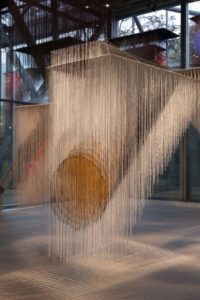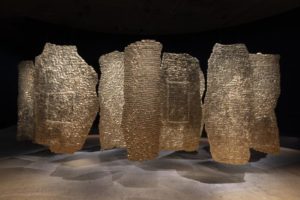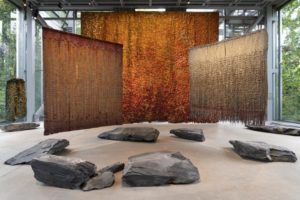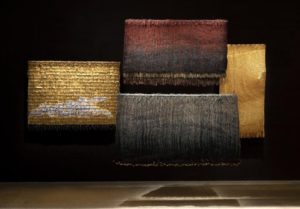February 13, 2025
Olga de Amaral. Until March 16, 2025 at Fondation Cartier pour l´art contemporain. Paris. Exhibition

The Fondation Cartier pour l’art contemporain is presenting the first major retrospective in Europe of Olga de Amaral, a key figure of the Colombian art scene and of Fiber Art. The exhibition brings together nearly eighty works made between the 1960s and now, many of which have never been shown before outside of Colombia. Beyond the vibrant goldleaf pieces for which the artist is renowned, the exhibition reveals her earliest explorations and experimentations with textile, as well as her monumental works.
Olga de Amaral
Since the 1960s, Olga de Amaral has been expanding the boundaries of the textile medium, continually experimenting with different materials (linen, cotton, horsehair, gesso, goldleaf, palladium) and techniques: she weaves, knots, braids, and interweaves threads to create monumental three-dimensional pieces. Her unclassifiable work draws equally from the Modernist principles that she discovered at the Cranbrook Academy of Art in the United States, and the vernacular traditions of her country, as well as pre-Columbian art. Having presented six works from the Brumas series as part of the Southern Geometries exhibition in 2018, the Fondation Cartier is now retracing Amaral’s entire career, celebrating the figure who helped spark a true revolution in the textile arts.
A new perspective on Olga de Amaral’s work
Despite her international renown, Amaral’s work has rarely been shown in Europe. This exhibition offers a fresh and exhaustive perspective on her career and unveils the full complexity of her artistic practice. Without adopting a strictly chronological order, it shines a light on the different periods that have characterized her artistic career: from her formal explorations (use of the grid, colors) to her experimentations (with materials and scale), as well as the influences that have nurtured her work (constructivist art, Latin-American handicrafts, the pre-Columbian era).
With this exhibition, the Fondation Cartier foregrounds the boldness of textile art, long marginalized due to the perception of it as a decorative art essentially practiced by women. Resolutely entwined with the dynamics of post World War II abstract art, Amaral’s ambitious production deviates from the conventional framework of traditional tapestry. The retrospective notably showcases her vital contribution to the artistic avant-garde of the 1960s, 70s and 80s.
Olga de Amaral




Olga de Amaral
Born in 1932 in Bogotá, Olga de Amaral is an emblematic figure of the Colombian art scene. Following a degree in architecture at the Colegio Mayor de Cundinamarca (1951-1952), she continued her studies at the Cranbrook Academy of Art in Michigan (1954-1955), which has been compared to Germany’s Bauhaus school. While there, she discovered textile art in the weaving workshop of Marianne Strengell, a Finnish-American artist and designer who was one of the first to favor the structure and grid of textiles over the pattern.
In the 1960s and 1970s, alongside Sheila Hicks and Magdalena Abakanowicz, Amaral contributed to the development of Fiber Art, using new materials and techniques drawing equally from Modernist principles and the folk traditions of her native country. Her large-scale abstract works free themselves from the wall and refuse any form of categorization.
At once paintings, sculptures, installations, and architecture, they envelop viewers in the artist’s sensorial, personal universe. Appointed ‘Visionary Artist’ by New York’s Museum of Art and Design in 2005, Amaral more recently received the Women’s Caucus for Art Lifetime Achievement Award in 2019. Her work can be found in major public and private collections worldwide, including those of the Tate Modern, the MoMA, the Musée d’Art Moderne de la ville de Paris and the Art Institute of Chicago. In 2021, the Museum of Fine Arts, Houston, dedicated
a major exhibition to her entitled To Weave a Rock.
Curator: Marie Perennès
Exhibition coordinator: Aby Gaye
Architecture of the exhibition designed by Lina Ghotmeh
To design the exhibition space, the French-Lebanese architect Lina Ghotmeh immersed herself in Amaral’s sources of inspiration: on the ground floor of Jean Nouvel’s building, surrounded by the garden by Lothar Baumgarten, she has created a landscape of slate stones connecting the interior, exterior, and the works, as though they were set in a stony, rugged landscape. On the below-ground level, the architectreuses the spiral motif found in some of Amaral’s works, to guide visitors through an enveloping space in which the artist’s explorations gradually emerge. Playing with contrast, scale and the position of the works, grazing the ground or hanging from the ceiling, Ghotmeh tells the story of the artist’s work through her own weaving of the Fondation Cartier’s space. She adopts an approach that she refers to as «archeology of the future» and draws her inspiration from the memory of the site and the works to immerse visitors into a timeless moment, rich in emotions and sensations.
More information, videos and interviews at https://www.fondationcartier.com/
Opening picture Exhibition view © Olga de Amaral – Picture © Cyril Marcilhacy